Swayamvara Stories
- October 7, 2022

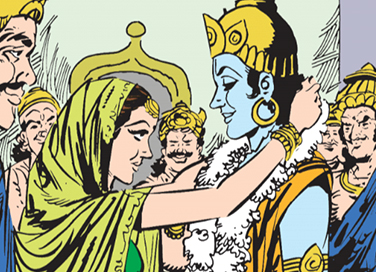
Swayamvara Stories
- October 7, 2022
By Srinidhi Murthy
In ancient India, a swayamvara was a practice that allowed a young maiden to choose her husband from a group of eligible suitors. There are many instances of swayamvara taking place in Indian mythology and some of these were monumental events that had far-reaching effects. Here are some such memorable swayamvara stories from mythology.
Nala was the generous and noble king of Nishada. He wished to marry Damayanti, the daughter of king Bheema of Kundanpur, after hearing about her from Sage Narada. One day, Nala saw a beautiful lake full of graceful swans. A small swan with golden plumes instantly caught his attention. He caught the swan by its leg and the bird cried out in pain. Nala assured the bird that he wouldn’t kill him, and that he wished to keep the swan in his palace.
To receive more such stories in your Inbox & WhatsApp, Please share your Email and Mobile number.
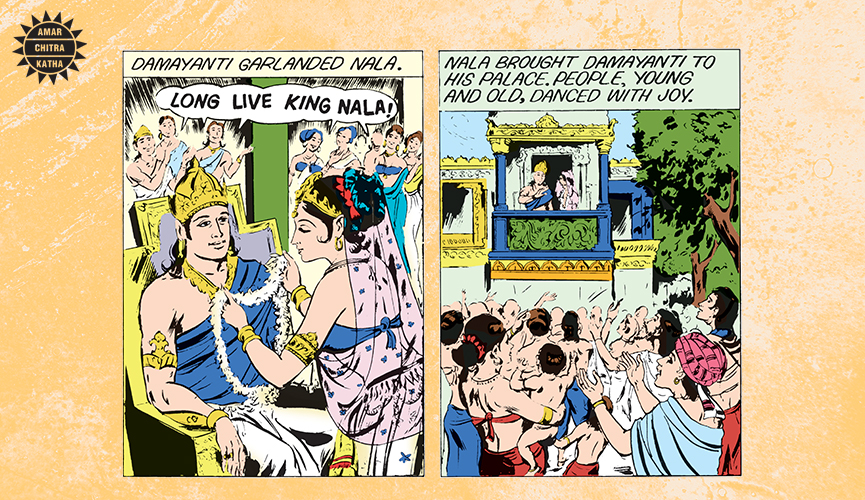
One day soon after, the swan saw Nala weeping. When questioned by the swan, Nala told him about his wish to marry Damayanti. The swan promised the king his help and left, with the intention of returning within a week. The swan flew away and reached the royal gardens of Kundanpur. There, the bird chanted Nala’s name in front of Damayanti. Damayanti was intrigued and asked him about the identity of Nala. The swan told her all about Nala and his excellent character. Impressed, Damayanti decided that she would only marry Nala. As promised, the swan came back to Nala and told him about what had transpired. Nala was so delighted with the news that he set the swan free and sent him back to the lake. Soon, a swayamvara was arranged for Damayanti and Nala was invited to the event. On the day of swayamvara, princes from various kingdoms had gathered in a hall, but Damayanti had eyes only for Nala. She immediately put the garland around his neck, declaring her choice. After their wedding, Nala brought Damayanti to his palace, much to the joy of his subjects.
Amba, Ambika and Ambalika were the daughters of the king of Kashi. The king decided to organise a swayamvara for his three daughters and invited all the eligible suitors to participate. With the permission of his stepmother Satyavati, Bheeshma, the chief of the Kurus, reached the swayamvara hall, on behalf of his brother, King Vichitraveerya of Hastinapura. He announced in the hall that he was going to take the three maidens with him to wed them to his brother and that he was ready to combat any king who would try to stop him.
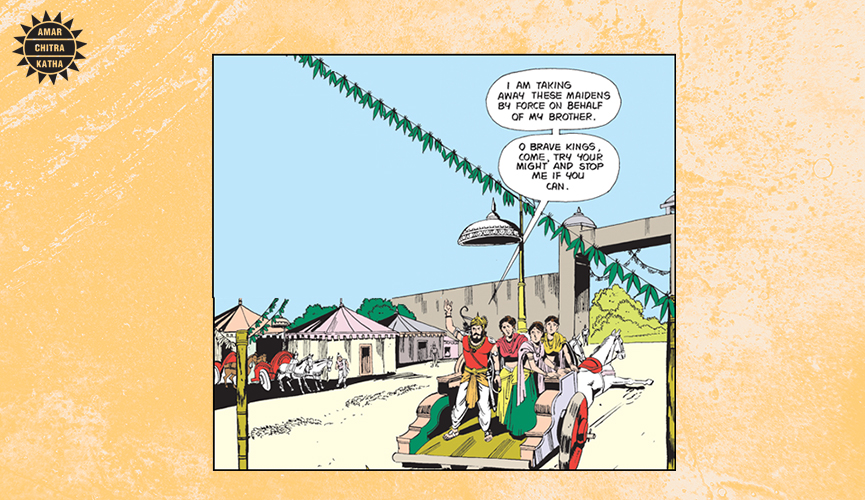
Many kings stood up in anger to fight against Bheeshma but were defeated. He took the princesses with him and turned his chariot towards Hastinapura. Suddenly he was stopped by Shalva, the king of Saubha, who challenged him to single combat. However, Shalva was no match for Bheeshma. Bheeshma slayed Shalva’s steeds and charioteer but spared his life. Soon, he brought the three princesses to Hastinapur and the wedding date was fixed. Before the ceremony, however, Amba, the eldest of the sisters, revealed that she had already chosen Shalva as her husband, even before her swayamvara. Bheeshma allowed Amba to return to Shalva and Vichitraveerya married Ambika and Ambalika in a grand wedding ceremony.
Pritha was the first-born child of Shoora, a Yadava king. Shoora had promised to give his first-born to the childless Kuntibhoja, the son of his paternal aunt. So, Pritha was adopted by Kuntibhoja and came to be known as Kunti in her new home. Kunti grew up to be a beautiful maiden. Hence, Kuntibhoja decided to arrange a swayamvara for her. He invited several kings and princes so that his daughter could choose her husband among them. Kunti looked at the assembled suitors and she chose Pandu, the king of Hastinapura, who looked resplendent in his royal attire. The wedding took place with full splendour and Pandu returned to Hastinapura with his wife and many gifts, presented by Kuntibhoja.
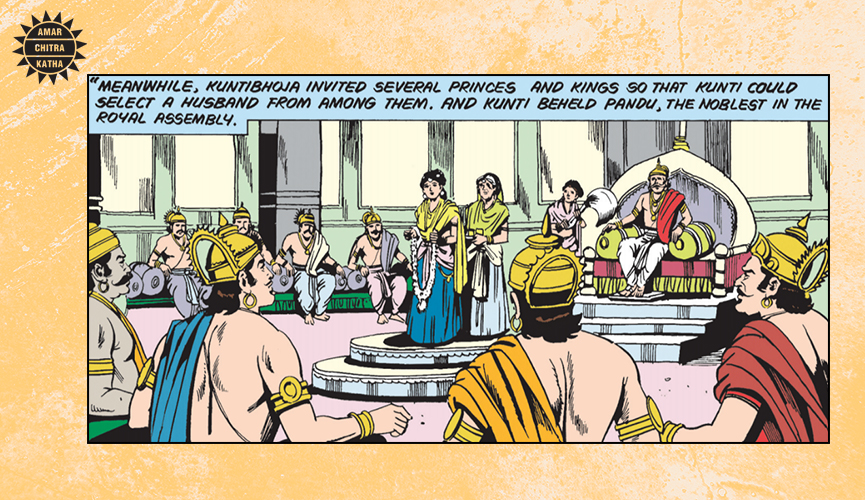
Draupadi was the daughter of king Drupada of Panchala. She emerged as a maiden, from the sacrificial fire with her twin brother, Dhrishtadyumna. Drupada decided to arrange a swayamvara for Draupadi, but with a contest. Drupada had always wanted Arjuna to wed his daughter. However, at the time, it was believed that Arjuna, with his four brothers and mother, had perished in a fire at Varanavata. Hence, Drupada decided to create an archery contest which could only be won by an ace archer like Arjuna. Unknown to others, the Pandavas and their mother, Kunti, was living in disguise as Brahmanas. Hearing of the swayamvara, they all arrived at Panchala.
On the day, Dhrishtadyumna announced that in order to win Draupadi’s hand, the suitors would have to string an enormous bow and then shoot five arrows simultaneously onto the eye of a revolving fish, through a revolving ring. Many kings, including Duryodhana, Karna, Shishupala and Jarasandha came to Panchala to participate in the swayamvara. The Pandavas were also in the hall, in their disguise. One by one, the suitors came, tried and failed. When Karna strung the bow and took aim, Draupadi refused to let him participate because he belonged to the Suta caste. It was then that Arjuna confidently stepped forward and his arrow found its mark. Full of joy, Draupadi garlanded Arjuna and this swayamvara changed the course of history for the entire Kuru clan.
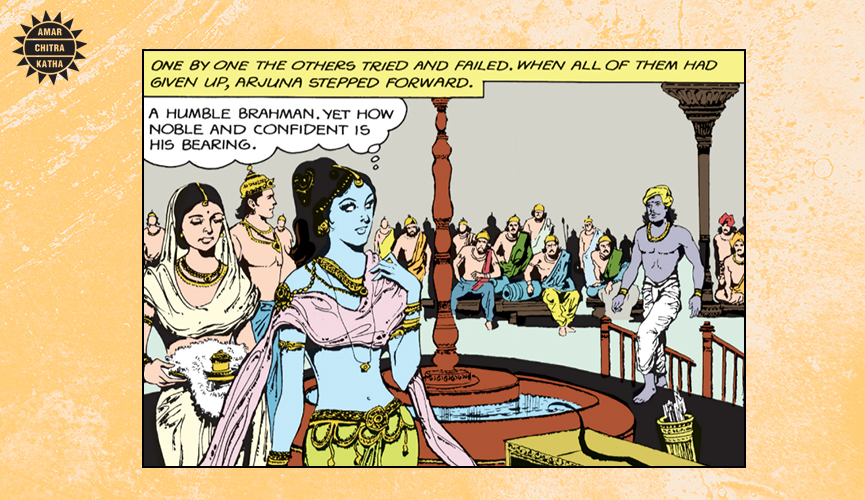
Lakshmana was the daughter of king Brihatsena. While she was courted by many prosperous kings, she was determined to marry Krishna and expressed her wish to her father. Brihatsena was happy with Lakshmana’s choice as he had great regard for Krishna and his prowess as an archer. However, the king was worried about the wrath of other kings who also wanted to marry Lakshmana. To avoid this, Brihatsena came up with the idea to hold a swayamvara with a contest. He told Lakshmana that only Krishna could emerge victorious in the contest and claim her hand, without offending other kings.
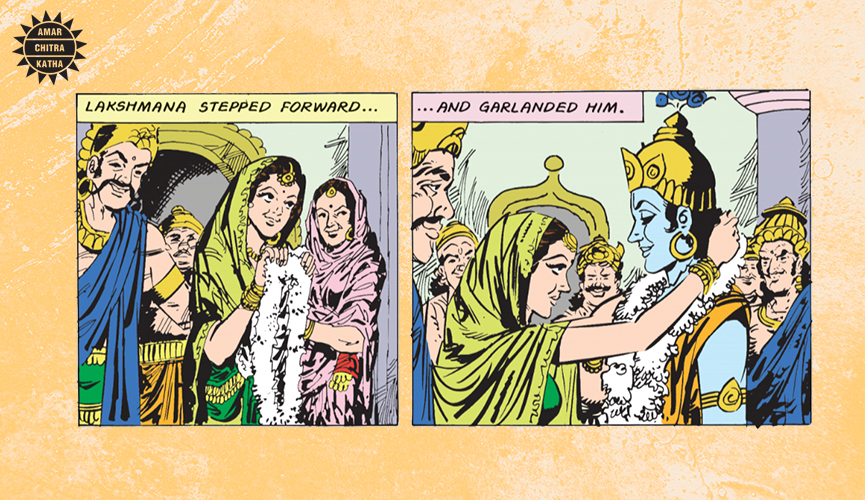
Invitations were sent to all eligible suitors including Krishna. When they all assembled for the contest, Brihatsena explained the rules to them. He said that the suitors had to attempt to shoot down the fish in a revolving machine, only by looking at its reflection in the water below. The contest turned out to be extremely difficult and many failed to even lift the bow. Some of them found it impossible to string it and those who successfully strung it, failed to shoot straight. Then Krishna came and lifted the bow with ease. He strung it with a smile and looked at the reflection, took aim and let go of the arrow. The aim was perfect and the fish came down in pieces. Lakshmana stepped forward happily and garlanded him. After taking leave of Brihatsena, Krishna and Lakshmana reached Dwaraka, where Rukmini and Satyabhama received them with joy.
To receive more such stories in your Inbox & WhatsApp, Please share your Email and Mobile number.
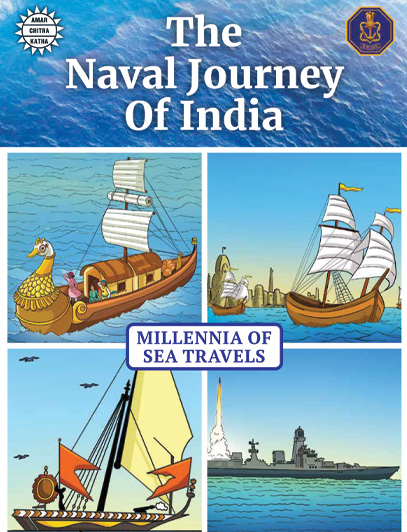
Comic of The Month
The Naval Journey of India Book I
This book is the first of a three-book series that takes a deep and detailed look at India's Naval History and a deep insight into the lives of our men and women in white. But any series on the Indian Navy has to start at the very beginning - exploring India's celebrated maritime history. Join our little hero, Bharat, and his grandfather, Commodore Sagar, as they sail into the deep blue waters of time. Book I of The Naval Journey of India takes a sweeping look at India's maritime endeavours, how the seas impacted us over millennia and how the oceans made us who we are.